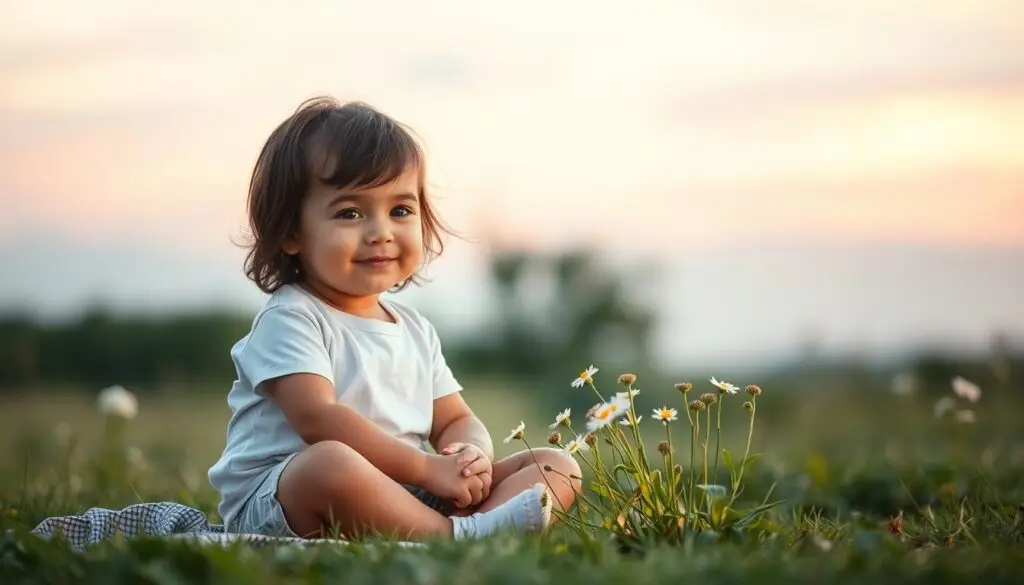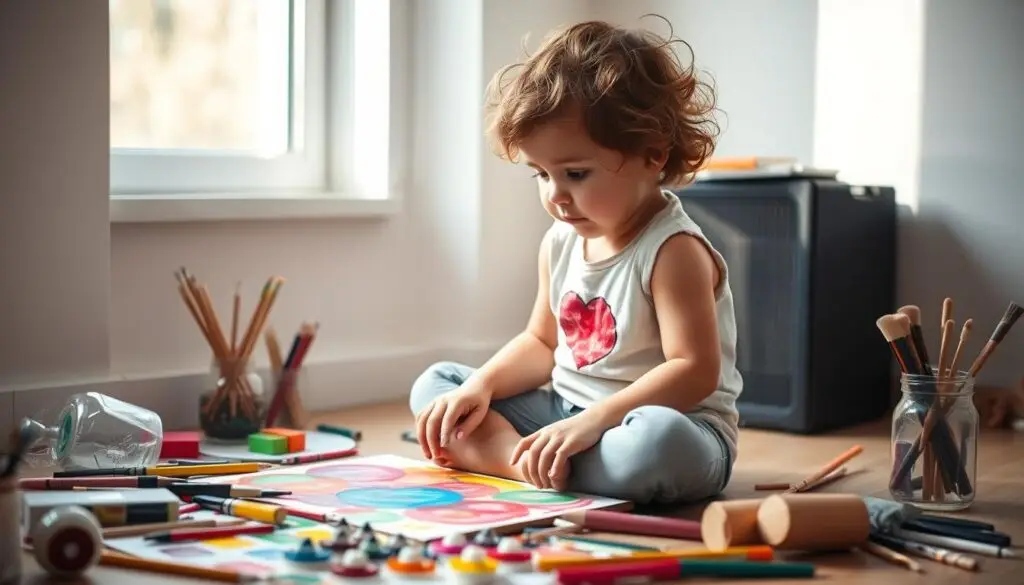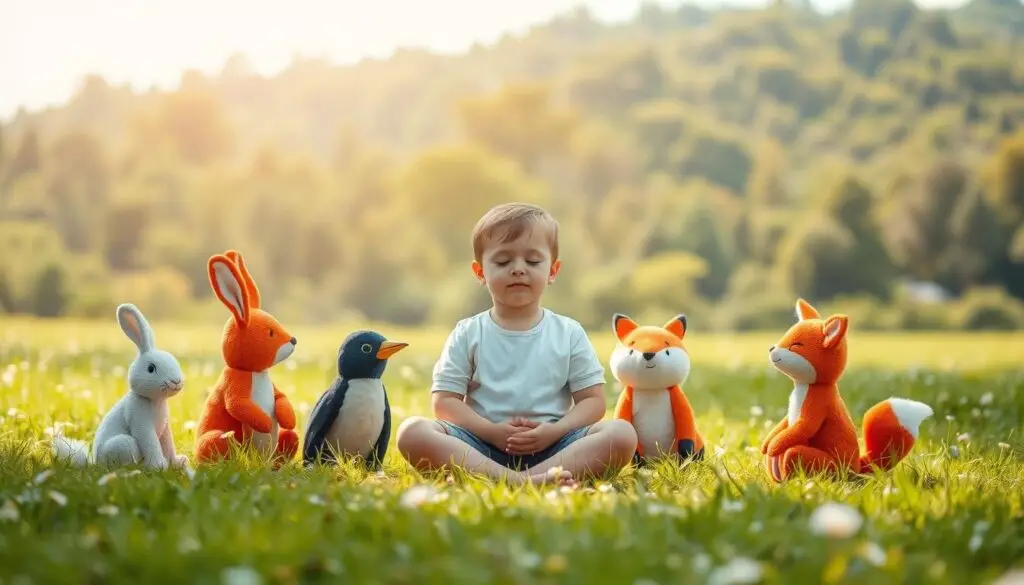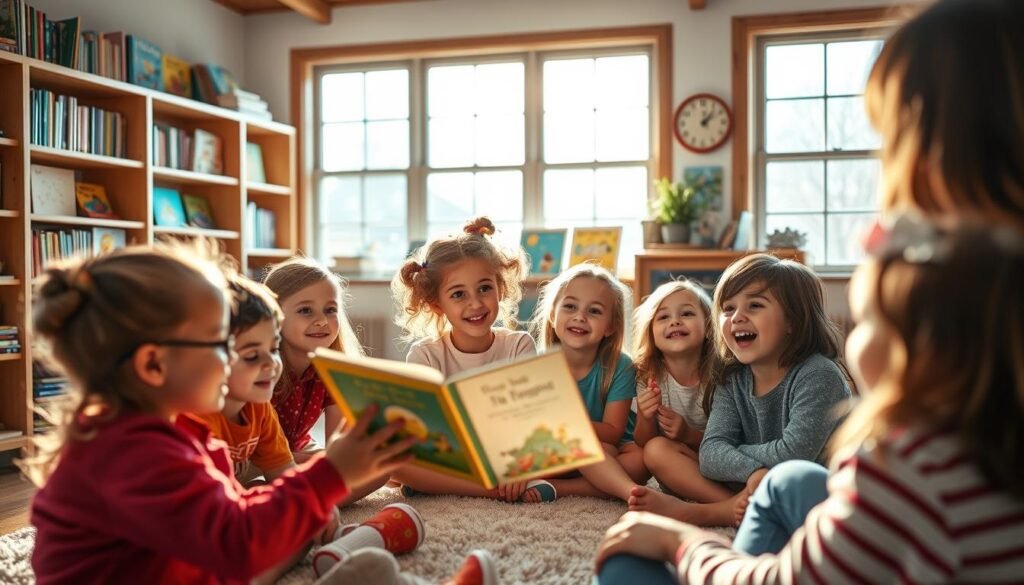Methods to Boost kids’ emotional growth using effective methods to boost emotional intelligence. Explore 5 creative ideas for nurturing emotional intelligence & well-being through various methods to boost growth.
Parents today understand that emotional growth is as important as academic learning for kids. Skills like empathy, resilience, and self-awareness help kids deal with friendships, challenges, and their feelings. This article offers five creative ways to help kids develop these skills through everyday activities.
By focusing on emotional growth, kids build a strong foundation for success in school, relationships, and life. These activities make learning emotional skills fun and natural for children.
Key Takeaways
- Emotional growth in kids leads to better problem-solving and stronger social bonds.
- Creative methods make learning emotional skills feel natural and fun for children.
- Early emotional development impacts academic performance and mental health outcomes.
- Simple daily practices can turn homes into spaces where emotional growth kids thrive.
- These strategies align with expert recommendations from child development researchers.
Understanding the Importance of Emotional Growth Kids
Emotional growth helps kids deal with life’s ups and downs and connect with others. Teaching child emotional development skills early on is key. These skills are the foundation for success in school, social life, and personal growth.
Why Emotional Intelligence Matters for Future Success
Research shows emotional intelligence (EQ) is more important than IQ for success. Kids who can handle their emotions become resilient and solve problems well. A Harvard study found that adults with high EQ earn more and have better relationships.
By focusing on early childhood emotions, you prepare kids to face challenges and setbacks.

How Emotional Growth Impacts Social Relationships
Children who understand their feelings connect better with others. Skills like empathy and conflict resolution come from healthy early childhood emotions. When kids can express their needs calmly, friendships grow stronger.
- Empathy reduces bullying and fosters teamwork
- Emotionally aware kids resolve disagreements without aggression
- They build trust by respecting others’ perspectives
The Connection Between Emotional Wellness and Academic Performance
Success in school isn’t just about being smart—it’s also about emotional stability. Kids who manage their emotions focus better in class. Schools see students with strong emotional skills do better in memory and staying on task.
“Emotional health is the hidden curriculum of education.”
By focusing on child emotional development, we help kids balance their emotions. This way, they can succeed in all areas of life.
Expressive Arts: Unlocking Emotional Awareness in Children
Art lets kids express feelings in their own way. Through drawing, music, dance, and sculpting, they can show their emotions. Even if they’re not good at art, parents can help them use colors, movements, or sounds to express feelings.

- Drawings: Sketch a “happy” or “worried” scene.
- Music: Play instruments to mimic emotions like calm or excitement.
- Dance: Move freely to show how emotions feel physically.
- Sculpting: Mold clay to represent abstract feelings like anger or joy.
| Art Form | Benefit | Example Activity |
|---|---|---|
| Painting | Visual self-expression | Ask, “What color is your sadness?” |
| Movement | Physical release | Dance to music that matches a mood |
| Sculpture | Tactile processing | Shape clay into emotions |
| Music | Auditory connection | Hum a tune for “brave” or “scared” |
Let your child explore without worrying about what you think. Ask them questions like, “Can you tell me about this?” or “How does this picture feel?” These questions help them share their thoughts without feeling judged. It’s important to celebrate their effort, not just the result.
Art helps kids connect their feelings to the world around them. By making art a regular part of their week, you create a safe space for them to grow emotionally. It’s not about being good at art, but about being honest and open through creative play.
Mindfulness Practices That Strengthen Child Emotional Development
Mindfulness isn’t just for adults—kids can learn it too. Simple methods help them notice their feelings before acting. This builds their child emotional development. Make mindfulness fun to keep them interested.

Age-Appropriate Meditation Techniques
Adjust practices based on maturity:
- Preschoolers: 2-minute “sensory walks” where they name colors or sounds.
- Elementary kids: Guided audio stories with calming music.
- Teens: 5-minute body scans using apps like Insight Timer.
Breathing Exercises for Emotional Regulation
Teach kids to calm down with these techniques:
- Bubble Breaths: Blow bubbles while breathing deeply to slow heart rate.
- 4-7-8 Breathing: Inhale 4 seconds, hold 7, exhale 8—use a timer to track progress.
Creating Mindful Moments in Daily Routines
Turn everyday tasks into practice opportunities:
- Eat one meal a day without screens, focusing on food textures and tastes.
- Use bedtime to discuss 3 positive experiences and 1 moment to improve.
Mindfulness becomes a habit when woven into routines. It gives children tools to manage stress and build self-awareness over time.
Storytelling as a Tool for Building Emotional Literacy in Kids
Stories let kids explore emotions in a safe way. Books, made-up stories, and acting out scenes can help them understand feelings better. This teaches them to talk about their emotions.

Using Books That Focus on Feelings
Look for books that clearly talk about emotions. For instance:
| Title | Author | Emotion Focus |
|---|---|---|
| “The Way I Feel” by Janan Cain | Janan Cain | Identifying basic emotions |
| “Enemy Pie” by Derek Munson | Derek Munson | Handling anger and friendship |
“Narratives that model emotional problem-solving improve children’s ability to manage stress.”
Creating Personalized Emotional Stories
Ask your child to write stories where they’re the main character. Ask them: “What would you do if your character felt scared?” This helps them think about how to handle real-life feelings.
- Pick a recent event they faced.
- Include their feelings and possible solutions.
- Discuss endings that show positive choices.
Role-Playing Emotional Scenarios
Act out situations like sharing toys or dealing with disappointment. Here’s how:
- Pick a common social challenge (e.g., sibling disagreements).
- Assign roles and have kids express their character’s feelings.
- Debrief afterward to connect the scenario to real emotions.
Role-playing makes complex emotions easier to understand. It makes them real and relatable for kids.
The Power of Play in Developing Emotional Intelligence Children
Play is more than just fun; it’s essential for building emotional skills in kids. Through play, children learn to handle emotions in a safe space. They might pretend to be doctors or astronauts, which helps their brains understand feelings and social signs.
Studies show that play-based activities help kids develop emotional intelligence. They encourage self-expression and problem-solving without stress. This is crucial for emotional growth.
- Pretend play lets children try out different roles, teaching empathy by seeing things from others’ viewpoints. A child acting as a teacher, for example, learns to grasp others’ feelings.
- Cooperative games like board games or team sports teach kids to manage frustration, take turns, and solve conflicts. These are key for emotional intelligence in kids.
- Physical play (running, dancing, or roughhousing) helps kids release stress and learn to control their emotions through movement.
Encourage kids to have unstructured playtime where they decide the rules. Sometimes, join in to show positive ways to interact, but let them lead. Play’s informal nature makes it incredibly powerful. When kids play, they build resilience and social skills naturally, without formal lessons.
Communication Strategies That Foster Emotional Skills Building
Effective communication is key for your child’s emotional skills building. By using these strategies every day, you make a safe space for them. Here, they feel heard and understood.
Validating Your Child’s Feelings
Begin by accepting their emotions without judgment. Say things like, “It’s okay to feel angry right now.” This shows you get it. Don’t say they’re overreacting. Validation means seeing their side, not agreeing with it. Emotional skills building grows when kids know their feelings are real.
Teaching Emotional Vocabulary
- Introduce words like “frustrated,” “excited,” or “disappointed.”
- Use books or movies to talk about characters’ feelings: “How do you think she felt when that happened?”
- Help them name their feelings when they’re calm to build self-awareness.
Active Listening Techniques for Parents
Listen without interrupting. Show you’re paying attention by nodding and making eye contact. Repeat back what they said: “You’re upset because your friend canceled plans?” This shows you get it.
“Children mirror what they see and hear. When parents model active listening, kids learn to express emotions thoughtfully,”
says child development expert Dr. Emily Carter. Regular practice helps them share their feelings more clearly.
Creating an Environment That Supports Children’s Emotional Wellness
Every home can be a place for emotional growth. By making small changes, you can create a safe space for kids to explore their feelings. These changes help them manage their emotions and become more resilient.
Setting Up Emotional Safe Spaces at Home
Choose a spot where kids can go to think about their feelings. Add soft blankets, drawing tools, or calming toys. Tell them it’s their “feelings corner” where all feelings are okay. You can include things like:
- A “feelings jar” with emotion cards
- Soft lighting or fairy lights
- Blank journals for drawing or writing
Establishing Routines That Promote Emotional Security
Having a regular daily routine helps kids feel secure. Try these activities:
- Bedtime chats about the day’s highs and lows
- Weekly family meetings to discuss concerns
- Morning check-ins with emotion checklists
Modeling Healthy Emotional Expression
“Children mirror the emotional climate they witness daily.” – National Institute of Child Health and Human Development
When you feel frustrated, say it out loud: “I’m feeling overwhelmed right now, so I need to take five deep breaths.” Show them how to solve problems calmly. This teaches them about emotions by watching you.
Small changes in your home and how you interact can make a big difference. They help create a place where kids can grow emotionally.
When to Seek Professional Support for Your Child’s Emotional Development
Every child grows emotionally in their own way. But how do you know when to ask for help? Signs like lasting sadness, aggression, or withdrawal might mean your child needs professional advice. This section will help you understand these signs and where to find help.
- Persistent sadness, anxiety, or fear lasting weeks
- Extreme behavioral changes affecting school or friendships
- Refusal to engage in activities once enjoyed
- Self-harm talk or drastic mood swings
Professionals can give your child the right help. Here are some experts to consider:
| Professional | Focus Area |
|---|---|
| Child Psychologist | Assesses emotional challenges and provides therapy |
| Play Therapist | Uses play to address emotional barriers |
| School Counselor | Supports academic and social-emotional challenges |
Talk to your pediatrician first if you’re worried. They can help find the right professional. Getting help early is a positive step for your child’s emotional health.
Conclusion: Nurturing Hearts and Minds for Lifelong Emotional Health
Everyday moments are key in helping kids grow emotionally. Practices like expressive arts, mindfulness, and storytelling fit well into family life. These activities help kids understand their feelings, build confidence, and connect with others.
Development is not always straightforward. Kids may face setbacks, but small, consistent routines help them keep moving forward. Celebrate small victories, like when a child names their emotions or shares a story. These moments build resilience and self-awareness.
As a guide, you play a crucial role in their journey. Showing honesty and patience teaches kids how to handle life’s challenges. By doing these activities together, you’re not just helping them. You’re also learning more about emotional needs and creating shared experiences.
Investing time in these strategies strengthens family bonds and prepares kids for the world. The skills they learn now will help them in relationships, learning, and personal goals for years to come. Small, intentional choices today can plant seeds for a lifetime of emotional strength and connection.
FAQ
What is emotional intelligence and why is it important for kids?
Emotional intelligence in kids means they can understand, share, and control their feelings. It’s key for their emotional growth. It helps them make friends, do well in school, and stay emotionally healthy as they grow up.
How can I foster emotional awareness in my child?
To help your child understand emotions, try reading books about feelings together. Encourage them to express themselves through art. Also, talk openly about their feelings and show you believe them.
What are some activities I can do with my child to boost their emotional development?
You can help your child by doing creative things like drawing or painting. Share stories that show different emotions. Try mindfulness together, like simple meditation or breathing exercises.
At what age should I start focusing on my child’s emotional growth?
Emotional growth starts early. Begin teaching emotional skills as soon as your child shows feelings. Keep going as they grow up.
How can I tell if my child is struggling with emotional issues?
Watch for signs like constant sadness, big changes in behavior, or trouble managing feelings. If you see these, talking to a professional might help.
What role does play have in developing emotional intelligence in children?
Play is vital for emotional growth. It lets kids try different roles, feel empathy, and learn social skills. Both structured games and free play help them manage their emotions.
How can I address and validate my child’s emotions?
To validate your child’s feelings, just accept them without judging. Say things like “It’s okay to feel sad” or “I get why you’re upset.” This helps them feel understood and encourages talking about their feelings.
When should I consider seeking professional help for my child’s emotional wellbeing?
If your child’s emotional problems last a long time or affect their daily life, get help. A pediatric psychologist or counselor can offer advice that fits your child’s needs.
Creative Methods to Boost Emotional Growth
Implementing these proven methods to boost emotional growth enhances overall well-being.
Lastly, these methods to boost emotional growth build a foundation for lifelong skills.
These engaging methods to boost emotional engagement foster connection and understanding.
Making use of methods to boost emotional resilience prepares kids for future challenges.
Integrating methods to boost emotional skills into daily life ensures consistent practice.
Methods to boost emotional growth can often be incorporated into playtime activities.
These strategies serve as effective methods to boost emotional awareness in children.
Utilize methods to boost emotional intelligence for a well-rounded upbringing.
Promoting methods to boost emotional skills is crucial in today’s challenging environment.
Incorporating methods to boost emotional insight can elevate their self-awareness.
These methods to boost emotional expression encourage kids to share their thoughts.
Utilizing these methods to boost emotional stability lays a strong foundation for children.
These methods to boost emotional skills can enrich family dynamics immensely.
Explore various methods to boost emotional growth that fit your family’s lifestyle.
Incorporating these methods to boost emotional understanding will yield positive changes.
These methods to boost emotional literacy are fundamental for effective communication.
Focusing on methods to boost emotional skills can enhance their daily interactions.
Employing these methods to boost emotional resilience is vital to children’s mental health.
These methods to boost emotional growth can lead to lifelong benefits for kids.
Through these methods to boost emotional awareness, children can better articulate their feelings.
Utilizing playful methods to boost emotional skills helps children express themselves freely.
These methods to boost their understanding of emotions can lead to healthier relationships.
Remember, these methods to boost growth are essential for a child’s overall development.
Implementing these methods to boost emotional expression can transform how kids interact.
These practical methods to boost emotional skills ensure children feel valued and understood.
Engaging in these methods to boost emotional learning creates a supportive environment.
By employing these methods to boost emotional intelligence, children can form better relationships.
These methods to boost their emotional skills will benefit children throughout their lives.
Incorporating methods to boost emotional resilience helps children navigate their feelings effectively.
Utilizing these methods to boost emotional awareness, you can foster deeper connections with your child.
These methods to boost emotional growth can be easily integrated into daily routines, making them practical for parents.
Share this content:
